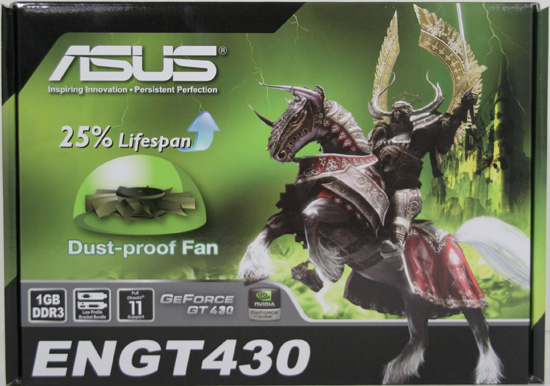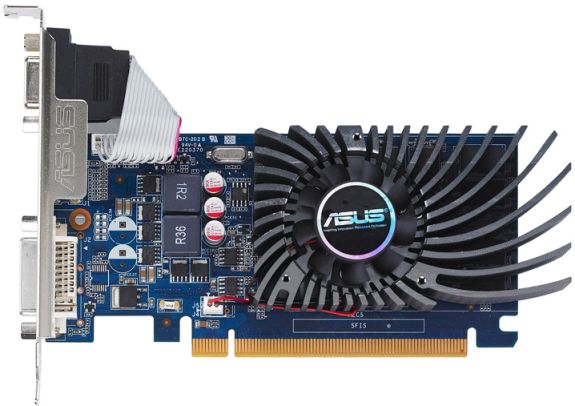NVIDIA's GeForce GT 430: The Next HTPC King?
by Ryan Smith & Ganesh T S on October 11, 2010 9:00 AM ESTMeet the Asus ENGT430
For our look today at the GT 430, Asus graciously provided us with their GT 430 card, the ENGT430. As with all the other cards being released it’s a custom design, featuring the usual Asus design elements: a double-sealed fan, fuse protection, and - while we have a hard time believing this is an issue on such a small card – GPU guard PCB reinforcement.
For this card Asus is very specifically going after the HTPC market. The ENGT430 is a half-height card with a low-profile bracket included, and for cooling it uses a decently sized heatsink with a particularly tiny fan we measure at 36mm. The heatsink does stick up some, so the card is explicitly a double-slot card and you’ll want to make sure you have space for it.
As is the case with low-end cards, reference clocks don’t tend to mean much. While the GT 430 has a reference speed of 700MHz for the core and 1.8GHz effective for the DDR3 memory, Asus has gone ahead and clocked the card at 1.6GHz for the memory. The card is equipped with 8 800MHz (1.6GHz effective) Hynix DDR3 memory modules running in 16bit mode, which is why the card is clocked below NVIDIA’s reference clocks. We expect to see memory clocks all over the place with the launch cards, depending particularly on who could get the best deal on what speed grade of DDR3 RAM for these cards. Given that GT 430 is likely already a memory bandwidth challenged card, this will have an impact, although we don’t have the means to measure it (our card would only go to 1.75GHz on the RAM).

For ports Asus is going with what’s undoubtedly going to be the universal configuration for low-profile GT430 cards: 1x DVI, 1x HDMI, and 1 VGA port. The DVI port is necessary for monitors (without resorting to a dongle), the HDMI port is necessary for HTPC roles, and the VGA port being an easy addition as an optional 3rd port due to its analog nature. GF108 can only drive 2 monitors at once, so the usual restrictions apply.
As is common for budget cards, there’s little else besides the card in the box. Asus includes the low-profile bracket, a multilingual quick installation guide, and a driver CD. This is the first Asus card we’ve reviewed for some time without voltage tweaking capabilities, so even NVIDIA’s integrated overclocking utility is enough for the task.












120 Comments
View All Comments
Ryan Smith - Monday, October 11, 2010 - link
None of the good product shots I have include passive GT 430s. However there are 2 in the collage on an NV slide: a Sparkle and a Zotac.ranger203 - Monday, October 11, 2010 - link
I have a Geforce G210 for my media center and it runs blu-rays well. I am looking for a little more umpppff to allow some post processing of other videos. But I paid $35 for my card, and the only way I would replace it was if this one was under $50.But.... a quick froogle search found they want to go for around $75. Giga-byte offers a passive cooler, looks pretty bad ass.
http://www.provantage.com/gigabyte-technology-gv-n...
Lolimaster - Monday, October 11, 2010 - link
Just buy a HD5550. You shoul've started buying an AMD IGP Mobo, that's enough.Nvidia on the low end is just worthless.
DMisner - Monday, October 11, 2010 - link
I noticed it has the same number of CUDA cores as the GT 240. Would this perform any better or about the same as the GT 240 for Folding@Home?AznBoi36 - Monday, October 11, 2010 - link
It's slower than the GT240. Also the GT240 is a full height card, while this one is low profile. There is a reason why this card is called the GT430 and not a GT440.mczak - Monday, October 11, 2010 - link
Hmm on page 1 it says roughly same die size as "Juniper GPU in the 5500/5600 families" - that should be redwood. Also, the "GT430 goes up against... GT430..." I guess that should be GT240?I'm really wondering how they attach 4 rops to two memory partitions btw. I believe that one quad rop per partition wouldn't really have required a lot of changes over one octo-rop per partition, but either the quad-rop block was split into 2 or it's actually attached to both MCs. Of course, for actual color fillrate, it doesn't really matter if there are 4 or 8 rops - pixel output is limited to 2 per SM anyway.
jsbiggs - Monday, October 11, 2010 - link
Additional correction:On the Power, Temperature, and Noise page, the line "Even at these low wattages where our 1200W power supply isn’t very efficiency". Probably should be "...isn't very efficient". Cheers.
Onferno - Monday, October 11, 2010 - link
Passively cooled and working as a PhysX card:http://www.hardwareheaven.com/reviews/1046/pg10/zo...
kmitty - Monday, October 11, 2010 - link
Depends on your definition of 'ultimate'. For me, just looking at it and seeing a fan meant it wasn't my ultimate HTPC card - absolute silence required!mcnabney - Tuesday, October 12, 2010 - link
No kidding.An ideal HTPC card is:
1. Silent
2. Consumes very little power
3. Can decode all current and pending video format/containers
4. Fits half-height as well
5. Has rock-solid driver support
6. Cheap
7. Bitstream audio and includes a full version of BluRay software to support it
This card just doesn't measure up. Ideally the best HTPC card isn't a card, but is actually part of the motherboard.